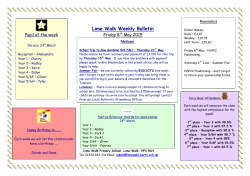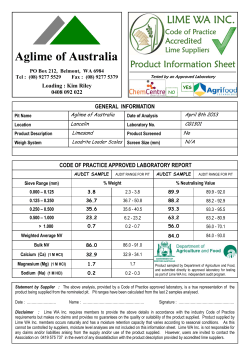
Roadbond Brochure
WHAT IS ROADBOND EN 1 ™ ? ROADBOND EN 1™ is a patented soil stabilizer developed by CSS Technology, Inc. It is easy to use, cost effective and environmentally harmless according to the US Forest Service. Now more than ever, the transportation and construction industries are seeking innovative products that will reduce common reoccurring failures and promote a sustainable environment. ROADBOND EN 1 is a widely used soil stabilizer that saves time, money and natural resources. ROADBOND EN 1 has three main uses: • Replaces lime stabilization • Reduces Portland cement and flyash • Reinforces strength of base material and recycled in-place material ROADBOND EN 1 contains strong oxidizers, powerful solvents and natural dispersants. The interaction of these compounds in the soil: • • • • Increases strength and strength improves over time Reduces permeability Controls shrink and swell Increases dry weight Field trials, lab tests and years of general use in various climates, soil types, traffic loads and construction methods have led to the wide-spread acknowledgment of ROADBOND EN 1 as an effective soil stabilizer. Thousands of projects completed since 1986 on six continents offer conclusive evidence of its reliability. ROADBOND EN 1™ Patented Soil Stabilizer HTestedln The Lob•••Proven In The Field" Developed and Patented by: C55 Technology, Inc. I Tolar, TX 76476 Roodbond'Soil.corn I Info@Roadbond50il.com 800 305-6190 REPLACE LIME ROADBOND EN 1 is used instead of lime to stabilize saves over 60% in materials finished in a single operation projects are stabilized cost. clay subgrade soils and It is also placed, mixed, compacted and without the need to remix several days later. Many and paved in less than 5 days! Benefits: • Provides a working table for construction in adverse weather • Improves strength • Reduces swell potential • Reduces permeability and suction • Increases dry weight Advantages: • Saves over 60% of the cost of lime • Installs in one day ... no remix days later • No adverse reaction to high sulfates • Reduces water requirements Save Time, Money and Natural Resources Small Carbon Footprint And LessImpact On The Environment REDUCE CONVENTIONAL ROADBOND EN 1 is used to enhance Portland cement and flyash. STABILIZERS the strength gain of conventional This means the amount of conventional by 40% to 50% without a corresponding stabilizers stabilizer such as can be reduced drop in strength. Advantages • Saves up to 40% of the cost of conventional stabilizers • Reduces reflective block cracking • Less maintenance in the years after construction • Reduces the impact of material shortages • No delay waiting for third party vendor • Reduces water requirements Many tests clearly indicate a major strength gain when ROADBOND EN 1 is used. The Texas DOT conducted several strength tests on limestone base and Ayash, with and without ROADBOND The result was a strength increase that ranged from 200% to 400%! Save Time, Money and Natural Resources Small Carbon Footprint And Less Impact On The Environment EN 1. REINFORCE ROADBASE 1 is used to improve the strength of base material and recycled in-place Field trials and lab tests confirm that soil treated with ROADBOND EN 1 is much ROADBOND material. EN stronger than untreated material and that the strength improves over time. This allows reclaimed material and lower-quality local base to be used for many projects. These projects would otherwise require more expensive crushed stone to be transported jobsite. ROADBOND EN 1 saves time, transportation to the costs and natural resources. Untreated And Treated Roadbase, Magnified 60 Times And Viewed Through A Microscope. Notice the larger segments of soil particles. spaces are void areas. The black The larger segments are dissolved and dispersed with almost no voids. Crystallized mineral salts and natural cements fill the voids and the soil particles are bonded together. Advantages: • Increases strength and strength improves over time • More compaction & density • Longer durability • Increases load-bearing capacity • Reduces permeability • Less dust and erosion • Saves time, money and natural resources Texas DOT Loop 820 - Fort Worth, Texas At construction ENVIRONMENTAL IMPACT OF CONVENTIONAL STABILIZERS Growth and construction ROADBOND our time. have a profound EN 1 is a well established, impact on our environment, economy and proven product that addresses some of the important productivity. challenges of These challenges include the reduction of: • Construction use of water and natural resources • Greenhouse gas emissions • Dependence on non-sustainable sources of energy • Carbon footprint of projects Conventional stabilizers are high environmental and calcination of limestone. impact products that are principally derived from the mining This process requires limestone to be fired in kilns at over 1200 degrees C and for every ton of lime produced: • Over 8 tons of limestone must be quarried • 2000 kwh of energy is consumed • 1.3 tons of C02 is emitted Also, the EPA has identified emissions. (4) • Hydrogen (1) (2) (3) the lime manufacturing industry as a major source of hazardous air pollutant These emissions include: chloride • Arsenic • Chromium • Lead • Mercury (II Dept of Energy Report "Energy and Environmental Profile of the Bert Metz, Intergovernmental Ponel on Climate Change, / Rules and Regulations), (51 (31 u.s. Mining Industry", Miner and Upton, 2002, Energy Information Administration, (61 (41 EPA 420-F-00-013, (21 Climate Change 2007, Mitigation of Climate Change, Federal Register / Vol. 69, No.2 / Monday, January 5, 2004 (71 GreaterGood.org A SUSTAINABLE ENVIRONMENT ROADBOND EN 1 contributes to a sustainable environment in a number of important ways and may qualify for LEEDTMcredit under "Innovation in Design." ROADBOND EN 1 uses lesswater, energy and lowers C02 emissions and because it is concentrated: • One 5-gallon pail replaces 12 tons of lime (1 1/3 truck loads) . For instance, a 54,000 square yard project requires 300 gallons of ROADBOND EN 1 or 730 tons of lime. (80 truck-loads or more) In this scenario, the use of ROADBOND EN 1: WATER USAGE Saves Water: • ROADBOND EN 1 uses 60,000 gallons of water • Lime requires 405,000 gallons of water • 675% lesswater • ROADBOND EN 1 • LIME Saves Energy: • ROADBOND EN 1 saves the energy consumed by 960 homes in one month • Lime consumes 2,000 kwh of electricity per ton produced (3) • Average home uses 936 kWh of electricity per month (5) Reduces green house gas: • ROADBOND EN 1 offsets C02 emissions by 936 tons (2) • That's like parking 1,650 cars for 1 month (6) • And not driving 1.7 million miles (6) • Or planting 312 fast growing pine trees (7) ROADBOND EN 1 No No No No No Mining . Kilns . Greenhouse Gas Dust . Particulate Emissions No Heavy Metal Emissions .. Conventional Stabilizers
© Copyright 2025









